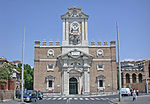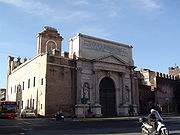
Porta Pia
Encyclopedia

Aurelian Walls
The Aurelian Walls is a line of city walls built between 271 and 275 in Rome, Italy, during the reign of the Roman Emperors Aurelian and Probus....
of Rome
Rome
Rome is the capital of Italy and the country's largest and most populated city and comune, with over 2.7 million residents in . The city is located in the central-western portion of the Italian Peninsula, on the Tiber River within the Lazio region of Italy.Rome's history spans two and a half...
, Italy
Italy
Italy , officially the Italian Republic languages]] under the European Charter for Regional or Minority Languages. In each of these, Italy's official name is as follows:;;;;;;;;), is a unitary parliamentary republic in South-Central Europe. To the north it borders France, Switzerland, Austria and...
. One of Pope Pius IV
Pope Pius IV
Pope Pius IV , born Giovanni Angelo Medici, was Pope from 1559 to 1565. He is notable for presiding over the culmination of the Council of Trent.-Biography:...
's civic improvements to the city, it is named after him. Situated at the end of a new street, the Via Pia, it was designed by Michelangelo
Michelangelo
Michelangelo di Lodovico Buonarroti Simoni , commonly known as Michelangelo, was an Italian Renaissance painter, sculptor, architect, poet, and engineer who exerted an unparalleled influence on the development of Western art...
in replacement for the Porta Nomentana
Porta Nomentana
The Porta Nomentana was one of the gates in the Aurelian Walls of Rome, Italy. It is located along viale del Policlinico, around 70 m east of Porta Pia. It is now blocked and merely a boundary wall for the British Embassy.-History:...
situated several hundred meters southwards, which was closed up at the same time. Construction began in 1561 and ended in 1565, after the artist's death. A 1561 bronze commemorative medal by Gianfederico Bonzagna shows an early plan by Michelangelo, very different from his final design.http://www.britishmuseum.org/explore/online_tours/europe/michelangelo_money_and_medals/bronze_medal_of_pius_iv.aspx. The façade on the outside of the city was completed in 1869 under the Neo-Classicist design by Virginio Vespignani
Virginio Vespignani
Virginio Vespignani was an Italian architect.Vespignani was born in Rome. A student of Luigi Poletti, he was highly interested in classical architecture, becoming one of Roman neoclassical academism's main figures....
.
History
A replacement was needed because of the new urban area, which could no longer provide access through the ancient Porta Nomentana for the Via NomentanaVia Nomentana
Via Nomentana is an ancient road of Italy, leading North-East from Rome to Nomentum , a distance of . It originally bore the name Via Ficulnensis, from the old Latin village of Ficulnea, about from Rome. It was subsequently prolonged to Nomentum, but never became an important high road, and merged...
. According to Vasari, Michelangelo presented three different designs to the Pope, which were beautiful but too extravagant, and the Pope (perhaps not very convinced by certain details of the drawings) chose the cheapest of the three No trace survives of the three drawings (except for some sketches for certain details), nor is it certain that the work was actually carried out to the original plan. The present appearance underwent several changes: the designs depicted on a commemorative coin minted in 1561 and in an engraving of 1568 (the only documentation of this epoch) present the Porta Pia quite differently from how it appears today. Moreover, even forty years after its construction, the gate was shown on maps of Rome as almost like a ruin. In any case, the gate depicted on the coin appears to be the closest to the initial plan, although we cannot exclude the possibility that in the course of works some variations and reviews were made to the design and its details, remembering that the Pope chose the cheapest design. It was, however, Michelangelo's last architectural work - he died shortly before the work was completed. The work was carried out by Giacomo Del Duca
Giacomo del Duca
Giacomo Del Duca was an Italian sculptor and architect during the late-Renaissance or Mannerist period...
, who also built Porta San Giovanni
Porta San Giovanni (Rome)
Porta San Giovanni is a gate in the Aurelian Wall of Rome, Italy, named after the nearby Basilica di San Giovanni in Laterano.-History:It is made up of a single grand arch built for pope Gregory XIII in "opera forse" by Giacomo della Porta or, it is argued, Giacomo del Duca, who had collaborated...
.

Fornix
The fornix is a C-shaped bundle of fibers in the brain, and carries signals from the hippocampus to the hypothalamus.-Structure:...
.
A second arch was opened around 1575 to facilitate the transit of traffic, significantly increased by the closure of the nearby porta Nomentana, as stated on the inscription over the central arch:
The prints and engravings up to 1577 depict a tower on the outside of a gate - it is doubtful whether this was lost from the design due to a collapse or due to a lessening desire for architectural motifs.
The external facade was completed in 1869 to neoclassical plans by Virginio Vespignani
Virginio Vespignani
Virginio Vespignani was an Italian architect.Vespignani was born in Rome. A student of Luigi Poletti, he was highly interested in classical architecture, becoming one of Roman neoclassical academism's main figures....
, who seems to have been inspired by an engraving of 1568 to follow Michelangelo's original plans quite closely. Beginning in 1853 with a restoration due to damage from a lightning strike in 1851, the works also included the addition of new buildings and a courtyard. The new facade, in keeping with the city walls, houses two statues each in their own niche (in this case, of saints Agnes
Saint Agnes
Agnes of Rome is a virgin–martyr, venerated as a saint in the Roman Catholic Church, Eastern Orthodox Church, the Anglican Communion, and Lutheranism. She is one of seven women, excluding the Blessed Virgin, commemorated by name in the Canon of the Mass...
and Alexander
Pope Alexander I
Pope Saint Alexander I was Bishop of Rome from about 106 to 115. The Holy See's Annuario Pontificio identifies him as a Roman who reigned from 108 or 109 to 116 or 119...
, according to the will of Pius IX), flanked by four columns. The Pope wanted a memorial to his escape from danger during the collapse of the audience chamber at the Sant'Agnese convent (near the gate) during his visit there on April 12, 1855. An inscription above the arch on the external side recorded this escape:
It was through an artillery-opened breach in the wall a dozen metres to the west of the gate - known as the "Porta Pia breach" - that on September 20, 1870 Bersaglieri
Bersaglieri
The Bersaglieri are a corps of the Italian Army originally created by General Alessandro La Marmora on 18 June 1836 to serve in the Piedmontese Army, later to become the Royal Italian Army...
soldiers entered Rome
Rome
Rome is the capital of Italy and the country's largest and most populated city and comune, with over 2.7 million residents in . The city is located in the central-western portion of the Italian Peninsula, on the Tiber River within the Lazio region of Italy.Rome's history spans two and a half...
and completed the unification of Italy. A marble and bronze monument is to be found at the exact point of the breach. Opposite the gate, on the external side, at the centre of the piazzale di Porta Pia, is the Monumento al Bersagliere, erected in 1932 by Publio Morbiducci on a commission from Mussolini. The buildings between the two arches of the gate, once housing the customs office, are now the seat of the Historical Museum of the Bersaglieri, with the monumental tomb of Enrico Toti
Enrico Toti
Enrico Toti was an Italian cyclist, patriot and hero of World War I.Enrico lost his left leg while working for Italian railways, at the age of 24. After his injury he became a cyclist....
.
Here, on September 11, 1926, the antifascist activist Gino Lucetti
Gino Lucetti
Gino Lucetti was an Italian anarchist and would-be assassin.Born in Carrara, Italy, he fought in the assault troops during World War I. Later he emigrated to France, from where he returned to attempt the assassination of Benito Mussolini, Italy's Fascist Duce...
threw a bomb against the car transporting Benito Mussolini
Benito Mussolini
Benito Amilcare Andrea Mussolini was an Italian politician who led the National Fascist Party and is credited with being one of the key figures in the creation of Fascism....
, but without effect.
See also
- Capture of RomeCapture of RomeThe Capture of Rome was the final event of the long process of Italian unification known as the Risorgimento, which finally unified the Italian peninsula under King Victor Emmanuel II of the House of Savoy...

